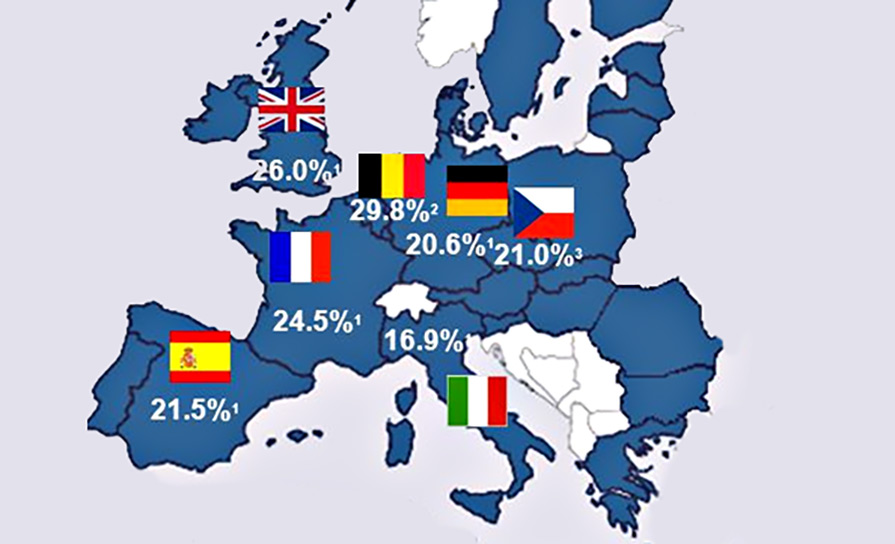A review of the use of biosimilar rituximab in non-Hodgkin lymphoma, using Irish data
The anti-CD20 monoclonal antibody rituximab is a well-known therapeutic agent used across many medical specialities. It first came to prominence in 1997 following its US FDA-led approval as an intravenous formulation for the treatment of relapsed or refractory, low-grade or follicular B-cell non-Hodgkin lymphoma.
Over the next 10 years rituximab swiftly became the cornerstone of most multi-agent chemotherapy regimens used to treat B-cell non-Hodgkin lymphomas, both low-grade and high-grade, as well as chronic lymphocytic leukaemia (CLL).
Thereafter, rituximab also found a niche in the treatment of other non-malignant B-cell mediated disorders. Licensed indications for rituximab include in rheumatoid arthritis in combination with methotrexate for adult patients with moderate to severe disease with an inadequate response to anti-tumour necrosis factor (TNF) therapy; granulomatosis with polyangiitis; microscopic polyangiitis in combination with glucocorticoids; and moderate to severe pemphigus vulgaris. Rituximab also has a number of off-label uses, some of which include the treatment of Epstein-Barr virus (EBV)-related diseases such as haemophagocytic syndrome; renal disorders such as lupus nephritis; myasthenia gravis; thrombotic thrombocytopaenic purpura; and autoimmune haemolytic anaemia, among many others.
The mechanism of action of rituximab is two-fold; firstly, it binds to the CD20 antigen on the surface of B-cells activating complement-dependent cytotoxicity, and secondly it binds to human Fc receptors mediating cell destruction through antibody-dependent cellular toxicity. Numerous rituximab iterations have been approved based on the success of the original formulation. These have included subcutaneous rituximab for CLL and non-Hodgkin lymphoma as well as second and third generation anti-CD20 monoclonal antibodies such as ofatumumab and obinutuzumab, both of which have been used in B-cell malignancies with relative success.
Cancer-related healthcare costs and the rise of generic products
Despite the clear efficacy of rituximab across many diseases, access to this biologic agent can be hampered due to high cost. The increased cost of more modern, technologically advanced and targeted chemotherapeutic agents and small molecule inhibitors has driven up the global burden of healthcare-associated costs relating to cancer treatment. In a climate of ever shrinking healthcare budgets and rising healthcare costs, the rise of generic formulations of historically efficacious cancer therapies has been inevitable. Drugs such as imatinib are now off-patent and generic versions, which are chemically identical to their parent drug, are being used in many jurisdictions in an effort to reduce healthcare budgets.
With many patents relating to rituximab expiring over the past five years, we have seen the rise in biosimilar products reaching the market. Due to the manufacturing method of monoclonal antibodies, or biologic agents, it is not possible to create identical replicas of the originator product.
A biosimilar denotes a biologic agent that is highly similar to the original product and to achieve approval through the FDA or the European Medicines Agency (EMA) in the European Union (EU), biosimilars must go through a rigorous evaluation to be shown to be similar to the reference product in terms of potency, purity, efficacy and safety.
Despite the purported benefit of reduced costing, biosimilar rituximab may still have significant market competition, with some physicians being reluctant to switch from the reference product; with reference product price reductions and alternative methods of administration; and second- and third-generation anti-CD20 biologic agents being marketed with purported greater efficacy than rituximab.
Evidence of efficacy of biosimilar rituximab
The addition of rituximab to standard chemotherapy in CD20-positive B-cell malignancies is widely regarded as a seminal advance in the treatment of these malignancies. In the MInT trial of younger patients with good prognosis diffuse large B-cell lymphoma (DLBCL) the addition of rituximab to CHOP chemotherapy improved six-year event-free survival from 55.8 per cent to 74.3 per cent. The clinical trial leading to the approval of reference rituximab in DLBCL demonstrated a complete response rate of 76 per cent at the end of treatment compared to 62 per cent in patients who received CHOP alone.
The addition of rituximab to standard chemotherapy in DLBCL prolongs both event-free and overall survival. Despite its aggressive nature, 50-70 per cent of patients with DLBCL can be expected to be cured by R-CHOP chemotherapy.
A number of rituximab biosimilars have been manufactured over the last number of years. Currently, there are two EMA-licensed biosimilars of rituximab in the EU, Truxima (CT-P10) and Rixathon (GP2013), however, the latter is not available in the Republic of Ireland at present. Five further rituximab biosimilars are currently in development by other pharmaceutical companies, with Mabion being at the most advanced stages of development with its product following a submission to the EMA for consideration in 2018.
Truxima and Rixathon received EMA approval for all licensed indications for reference rituximab on the basis of pre-clinical pharmacodynamic and pharmacokinetic studies, as well as phase 3 clinical studies utilising the biosimilar product in advanced stage follicular lymphoma and in rheumatoid arthritis. In order to receive EMA approval, non-inferiority was required to be demonstrated for the above diseases. Once non-inferiority was demonstrated, the license was extended to all licensed indications for reference rituximab.
There have thus far been no phase 3 trials investigating Truxima or Rixathon specifically in DLBCL. As part of a pharmacy cost-containment strategy and in agreement with treating physicians, all new lymphoma patients prescribed rituximab in the Mater Misericordiae University Hospital from January 2018 have received the biosimilar product Truxima.
Local efforts to improve the knowledge base of biosimilar rituximab
We recently conducted a retrospective analysis of all lymphoma patients in the Mater Hospital who have received Truxima since January 2018. This data was presented at the Haematology Association of Ireland Annual Meeting in Galway in October 2019. The objective of this study was to carry out an analysis of patients attending the Mater Hospital with DLBCL receiving Truxima to assess its efficacy and safety compared to reference rituximab.
In this analysis, the medication workflow BD Cato was accessed and all patients who have received the R-CHOP, R-mini-CHOP or dose-adjusted (DA)-R-EPOCH chemotherapy regimens for DLBCL since January 2018 were identified. Patient characteristics collected included age, gender, histology, regimen prescribed, R-IPI score, LDH, staging investigations and response investigations. Response rates were assessed for all patients using the Lugano response criteria for lymphoma.
A total of 25 patients have received Truxima for treatment of DLBCL since January 2018 in the Mater Hospital and were included in the response assessment. Patient characteristics are outlined in Table 1. The most frequent regimen prescribed was R-CHOP (n=20), R-mini-CHOP (n=3) followed by DA-EPOCH-R (n=2). The mean number of Truxima doses was eight (range four-eight). Nineteen patients have completed treatment for DLBCL, three patients are still receiving treatment, and three patients transferred to other institutions. Response rates for patients receiving Truxima were as follows: Complete response 68.4 per cent, partial response 10.5 per cent, stable disease 0 per cent, and progressive disease 21.1 per cent.
Our cohort, while small, demonstrates a similar complete response rate compared with data from clinical trials of reference rituximab in DLBCL. There is an argument that biosimilar products have been investigated to a less rigorous extent as their reference drug. Despite the limitations of small, retrospective cohort analysis, these studies are important to gather real world data on response rates of patients receiving biosimilar products.
It is worth noting in this cohort, the high number of advanced R-IPI scores, advanced stage disease, and advanced age. These are patients that are often omitted from clinical trials due to strict inclusion and exclusion criteria. The fact that not only Truxima performs similarly to reference rituximab, but that older patients with more co-morbidities and more advanced disease can also achieve complete remissions is an important observation.
Future directions
Further data collection and follow-up is required to further confirm the equivalent efficacy of Truxima in high-grade B-cell lymphoma compared with reference rituximab and it is expected that at the upcoming American Society of Hematology Annual Meeting in Orlando this month there will be a number of poster presentations from various countries analysing medium-term data on outcomes and toxicities of patients receiving biosimilar rituximab.
Collaboration between institutions both nationally in Ireland and internationally is crucial in order to collect real world data on the use of biosimilar rituximab for its various indications and national policies on medication procurement processes can drive down healthcare budgets substantially. It is possible that biosimilar rituximab may also find its way into the treatment armamentarium of clinicians using rituximab frequently for off-license uses and this data will be very interesting to capture and analyse.













Leave a Reply
You must be logged in to post a comment.